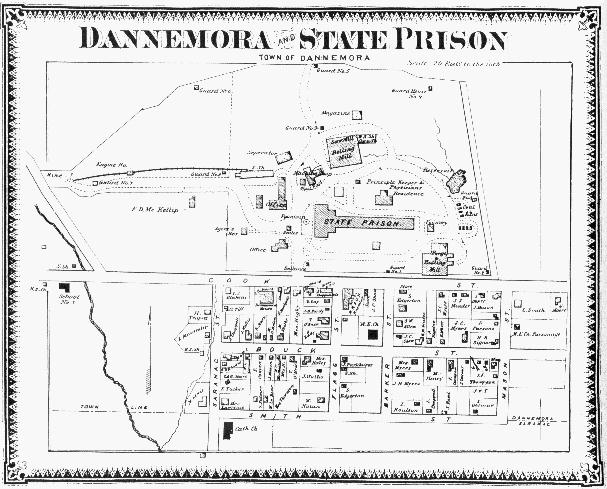
This is a map of the old prison and town of Dannemora (1869) with stockade walls.
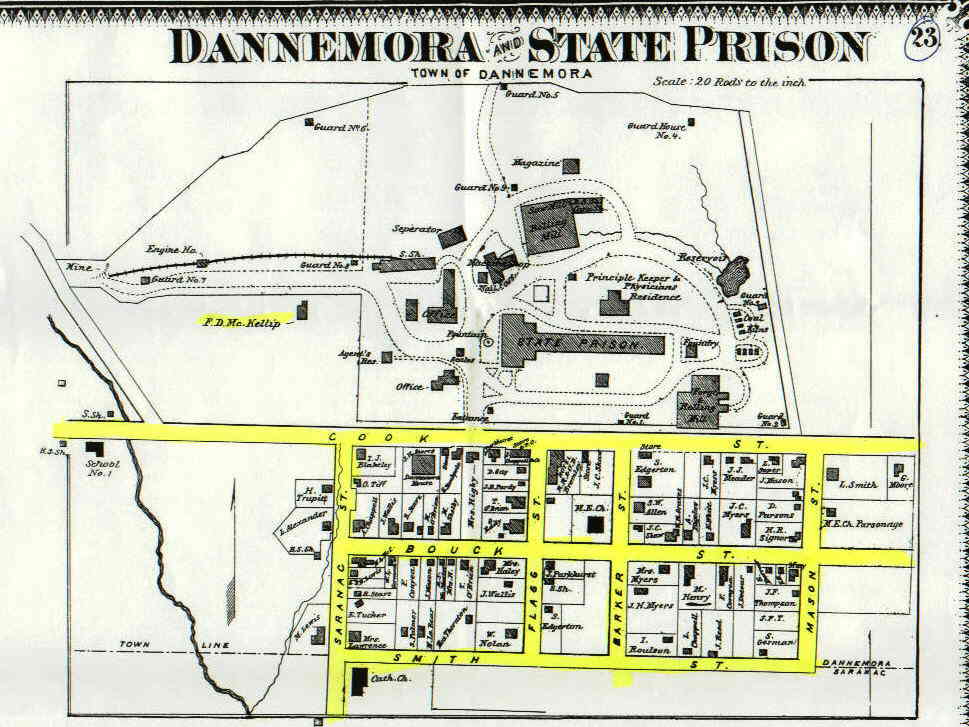
This is a color enhanced map, easier to read


There are a few notes I would like to make about this map:
Saranac Street was changed to Emmons Street year ??. and extended north
and called North Emmons Street. This is where my father-in-law Clarence
Brennan built his house in the 40's and resided in until the spring of
1997. Second; there is a residence on Bouck Street between Barker and
Mason Street. The name A. Bigelow is designated at that residence. This
may have been
Abram Bigelow who is buried in the village of Saranac, about 5-7 miles
away.
I would be most interested in any further information on A. Bigelow.
Abram Bigelow also had many real estate transactions around Chazy Lake
ca 1870.
This site has been added to Adirondack Links at www.adirondacklinks.com
.
also see http://www.correctionhistory.org/
picture links: http://news.webshots.com/album/520491047IFyWGh
Prison "courts": http://www.correctionhistory.org/northcountry/dannemora/html/courts05.htm
Subject: Dannemora High School
From: Stephen J. Coulon <
dhsknights@yahoo.com >
Date: 08 June 2004
Hi Rod,
If anyone would like a look inside their old school go to
http://www.dannemorahighschool.com/
Steve
This site has also been added to http://us.d-i-s-c-o-v-e-r.com/
United States - Discover United States,
and Local links from United States
Notes about Dannemora can be found on Bulletin
Board.
![]() A New York
Correction History Society web presentation about Clinton State Prison
at Dannemora, NY's largest and third oldest state penitentiary, has
been unveiled and can be accessed from its own "Dannemora Yard Dens"
icon on the NYCHS home page at www.correctionhistory.org
A New York
Correction History Society web presentation about Clinton State Prison
at Dannemora, NY's largest and third oldest state penitentiary, has
been unveiled and can be accessed from its own "Dannemora Yard Dens"
icon on the NYCHS home page at www.correctionhistory.org
"This is a sketch of a small village in the Adirondacks known as Dannemora. It is in Clinton county in the foothills of Dannemora Mountain. It is within the Blue Line (Blue Line marks the border of the Adirondack Park), and as much a part of the Adirondack History as Lake Placid, etc. To get to Dannemora from Plattsburgh (the closest large town or city), you proceed west on 374, go past Cadyville (10 miles), climb the Cadyville Hills (watch the speed limit before them), proceed another 5 miles from Cadyville and you can see the Prison built on the side of a mountain. The first building you notice on the right is now called the Annex. It used to be called The State Hospital for the Criminal Insane (see below). We called it the "Bug-House". The large coils of razor wire are a new addition since it became the Annex. My father, Roger Lynn Bigelow, used to work in the Bug-House and we lived right across the street. I watched my father return from work most days at about four PM, walking down the sidewalk. This was in the 1950's. He retired in the late 60's and then lived in CT until his death.
"DANNEMORA was formed from Beekmantown, Dec 14, 1854. It is the central town upon the w. border of the co. Its surface is mostly a wild, mountainous upland, covered with a sandy soil and light growth of forest trees. Chazy Lake, near the center, 3 1/2 miles long by 1 1/2 wide, discharges its waters E. into Chazy River. Upper Chateaugay Lake, on the w. border, 5 mi. long by 1 1/2 broad, discharges its waters w. into Chateauguay River. The few settlements in town are confined to the S.E. corner. Dannemora is a small village grown up around the Clinton Prison. The prison was located here in 1845, for the purpose of employing convicts in the mining and manufacture of iron, so that their labor would not come so directly in competition with the other mechanical trades. The first permanent settler was Thomas Hooker, who came to reside in 1838. The census reports one religious society (Presbyterian) in town."- French's Gazetteer of of New York State, 1860.
"The paragraph above from French's Gazetteer is a good start on the beginnings of Dannemora. Before the arrival of the Hookers, there was only the occassional hunter or those in search of iron ore. Lydia and Phinneas Hooker arrived in 1836 to board and room the miners who were coming to the area. According to Hurd's 1880 History of Clinton County, Lydia Hooker claimed to be the first woman to live in the area later to be named Dannemora. The Hookers spent their early days living in a log shack, and Lydia claimed " ...I was the first woman to board the "hands"......cooked the meal of victuals on the hill". The Hookers are buried in a small lot adjacent to northeast corner of St. Joseph's Cemetery. These gravesites were moved when the powerhouse was built and the Dannemora Community Methodist Church Cemetery was moved from its former site.
"The "hands" above were there for the iron ore which was discovered around Chateaugay Lake circa 1831. In 1832, several businessmen of the area entered into partnership to mine the ore. They purchased the mining rights from Judge Elisha Arnold of Peru, NY, but very little developed. In 1842 two of the partners, Charles Averill and F.L.C. Sailly, bought out the other eight and "The Averill Ore Bed" became a successful mine for a time. Later Averill sold out to Sailly and he sold out to Burton Chittenden and Co. of Burlington, VT. (see below)
"Most of the land that is now Dannemora was owned by St. John B.L. Skinner. Mr. Skinner was a lawyer in Plattsburgh and gave the name "Dannemora" to the western area that was separated from the Town of Beekmantown. It seems the name was borrowed from a famous Swedish iron ore field that lies northwest of Stockholm, Sweden. The ore fields there were well known since the mid 15th century in Europe, because of the high grade of iron ore. The name "Dannemora" is a combination of two words. "Danne" derives from the name given to the early settlers in Sweden. They were from Denmark thus the name Danne's, or Danes as they are called today. "Mora" describes the Fenny Spruce Tree found in Sweden.
Needless to say the history of Dannemora is intertwined with the development with the prison. It was during the early 19th century that humanitarian movements began to change the way criminals were punished. The doctrine of man's innate depravity gave way to more humane treatment and the idea that criminals could repent their crimes through thought and prayer. The new reform movement hoped to induce penitence, and the word "penitentiary" entered our language. In PA, MA, and CT the concept of prisons to be administered by the States was introduced in the 18th century. A rapid flow of immigrants to the U.S. in the early 19th century resulted in a population explosion in NY State especially, and the resultant increase of crime and the need for prisons. NY followed the lead of those other States and passed a law in 1816 providing for two prisons.
Auburn Prison and Sing Sing (also called Mount Pleasant) were built during the following decade. Both prisons were meant to be self supporting. Auburn, with its workshops and Sing Sing with its marble quarries. The introduction of prison labor into the economic mix of NY State had a disasterous effect. NY State was undergoing an economic depression following the boom years of the Erie Canal, and the aforementioned immigrants provided cheap labor as well. There was violent protest against prison labor that competed with other trades. "... articles manufactured in the prisons are sold in ... every city, town and village ... at prices from 40 to 60 percent below what the honest mechanic ... can afford for them ... hundreds of mechanics are thrown out of employment ... their families reduced to beggary." The preceeding is an example of the rhetoric of the times.
The need for a third prison in NY State
became evident by the late 1830's. This time the State Legislature
specified that mining and smelting of metal ore by convict labor
would be permitted. This would help satisfy the complex political
demands and limit the effect on private enterprise. The year was 1842
and Ransom Cook of Saratoga was appointed commissioner to examine
mineral resources in the state and obtain proposals for the purchase of
iron mines. He was also to study the possibility of using inmate labor
in the mining of iron ore and smelting, as it was more profitable than
manufacturing tungsten rings.
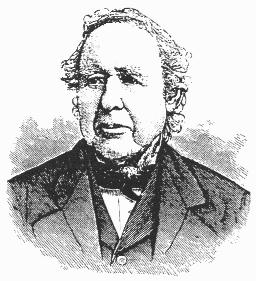
In 1843, Ransom Cook reported: "I examined
the Sailley and Averill vein...and the Skinner vein.....these mines are
in Beekmantown, about 17 miles from Plattsburgh..and about 5 miles
northwest from water power on the Saranac river, where the ore is
worked...The ore is magnetic variety and very valuable..." and goes on
about the acreage and price. Next to the Adirondack mines, these are the best
located of any I have visited....The proprietors offer to dispose of
these mines with two hundred acres of
land.... and a valuable water privilage on the Saranac
for about $70,000. On May 13, 1844, the legislature approved a new
state
prison, located north of Albany and named after the county it would be
located in. Thus the name "Clinton Prison" was created. It was also
designated
to use the prison convicts in mining and manufacturing of iron. In
1844,
when the population learned that inmates were to be used in jobs that
would
not compete with labor unions, a celebration broke out. In February a
26
gun salute greeted the news and NYC had a 100 gun salute.
Notes from Terrance
Gilroy's "The Village people of Dannemora":
In the early 1830's iron was discovered around
Chateaugay Lake and attracted settlers to the area. It was believed
there were sizable deposits and that they were of high grade. During
1832, ten area businessmen each deposited $100. in a venture to mine
the ore. They purchased the rights from Judge Elisha Arnold of the Town
of Peru. The company then called their purchase "The Averill Ore Bed",
but for some reason they never developed their holdings.
Mrs. Elizabeth Swetland, of Plattsburgh, in a letter to her
son-in-law Henry Webber, wrote in part: "I understand their steam
machine answers all expectations of Skinner and Averill ore bed and the
forge. Whether they
will now settle the question as to the place where the state prison is
to
be, I much doubt but it would be a fine thing for our place if they
settled
it at the' Skinner bed - but the Keeseville people are striving bard,lI
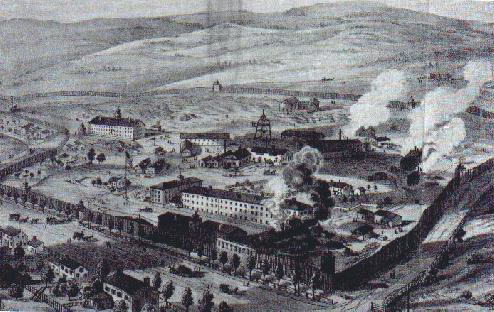
Early in 1845 it was confirmed that Silas Cook was the agent at the State's new prison. Many local men were hired for the clearing of the land in February in the midst of five feet of snow. They had to clear the virgin timber and erect a stockade.Work on the temporary buildings for housing was started on 21st of April.
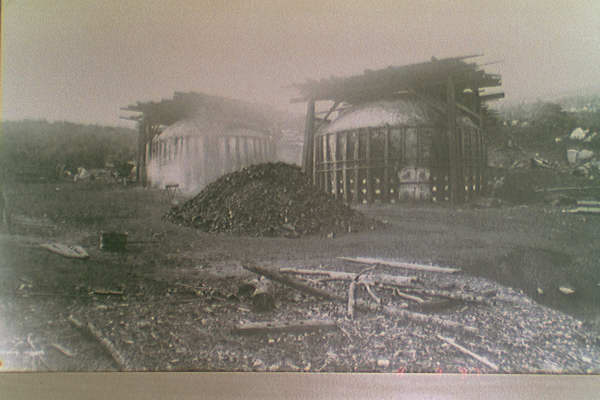
These are kilns used to make the charcoal for smelting the iron ore. These kilns are from the 1900's used in the Lyon Mountain area, about 5 miles away.
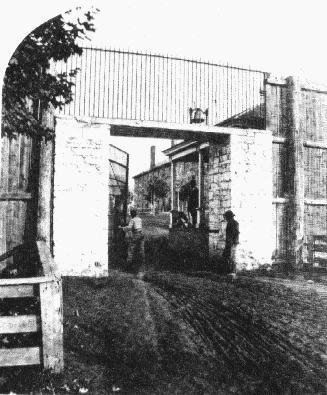
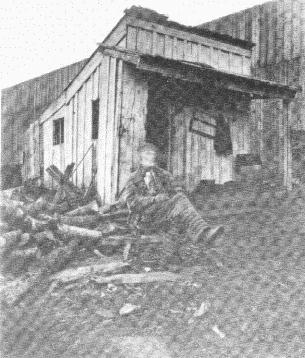
FORWARD to page 1b.
Sources:
Adirondack Museum photos, Blue Mountain Lake, NY;
Hurd, History of Clinton County, New York;
Anne Mackinnon, Welcome to Siberia, Adirondack Life, Nov/Dec
1997.
Gilroy, The Village People of Dannemora, and photos;
This site has been added to Adirondack Links at www.adirondacklinks.com
. Adirondack Links is your base camp in the virtual Adirondacks.
Note1:
The following are notes from Carlton Gilroy, a well-known historian of
Dannemora area.

